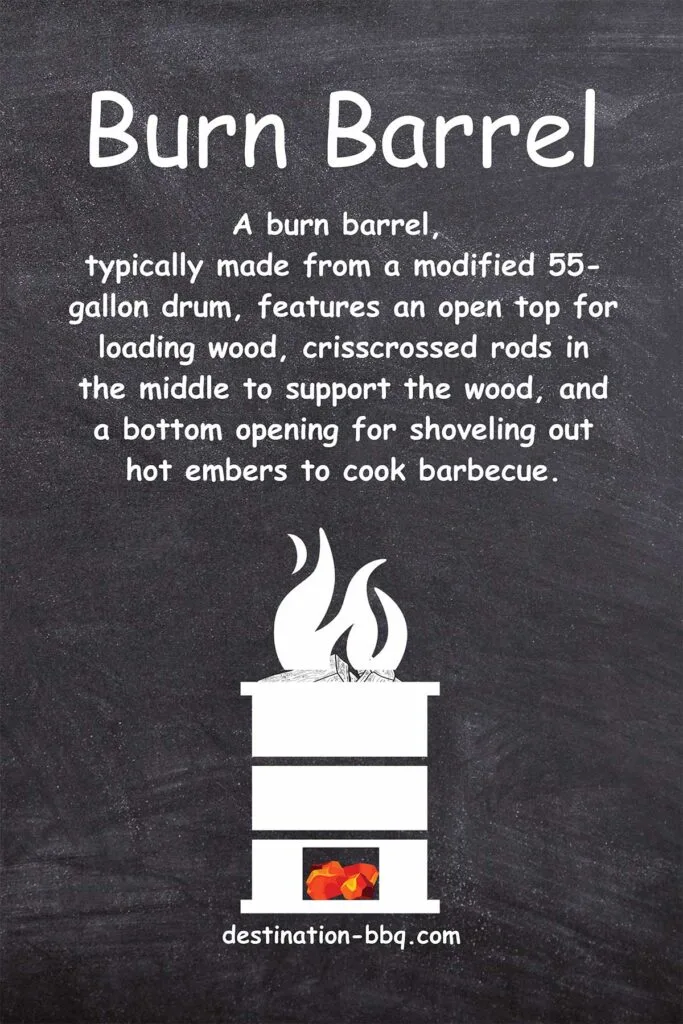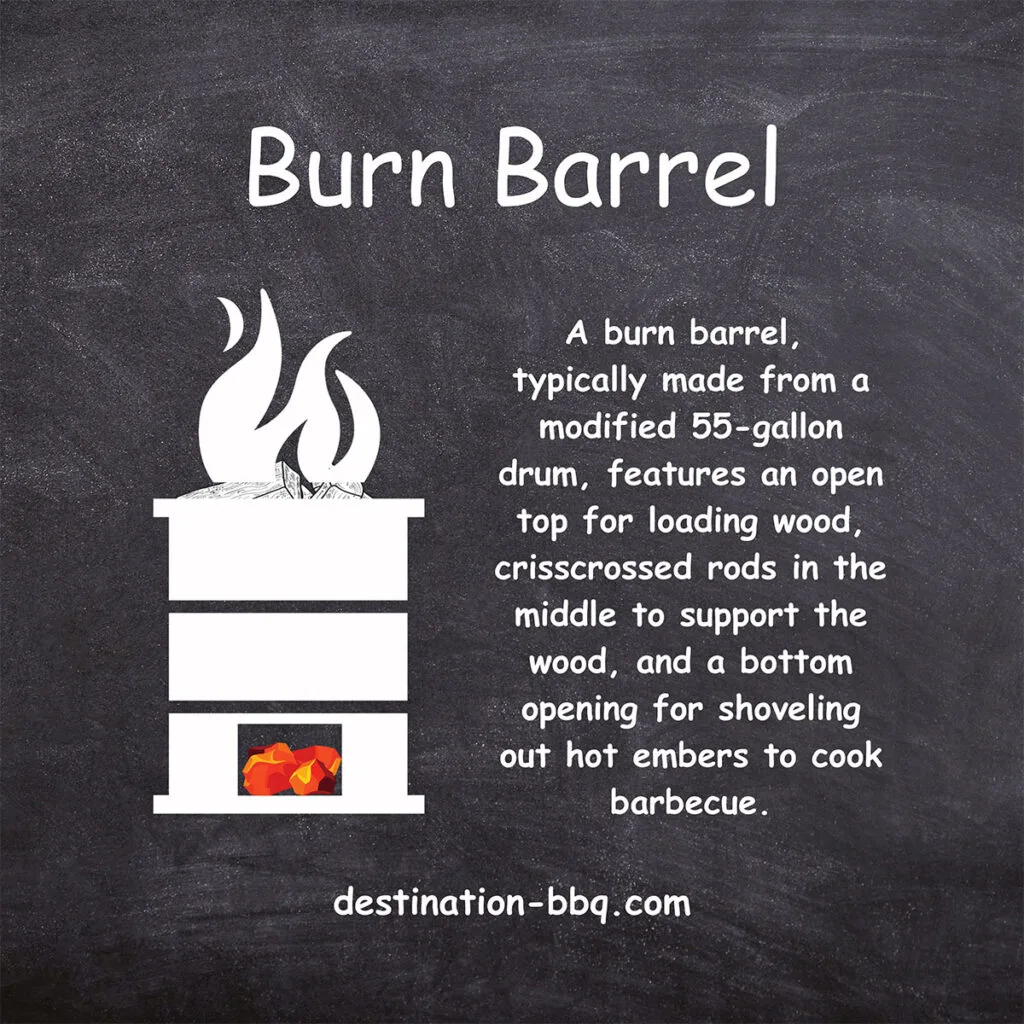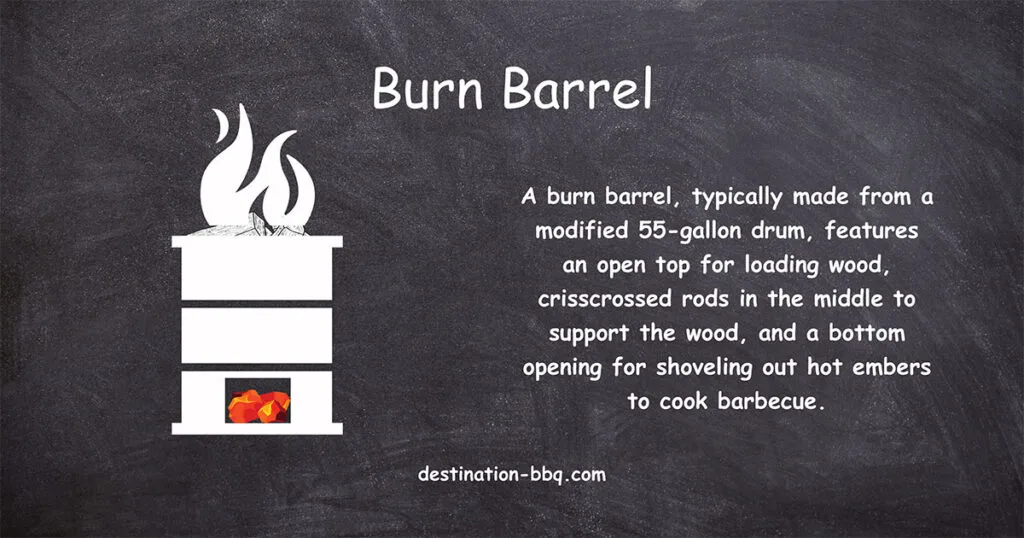
What is a Burn Barrel?
A burn barrel is typically a modified 55-gallon drum used for creating wood embers for cooking barbecue. Constructed from repurposed steel drums, burn barrels feature an open top for loading hardwood logs and crisscrossed rods inside to hold the wood in place. As the logs burn, the embers fall to the bottom through a shovel opening, providing coals for long cooks like whole hogs.
Key Takeaways
- A burn barrel is a modified 55-gallon drum, loaded with hardwood logs, that produces embers providing a consistent and reliable heat source for long-duration cooks, particularly when smoking a whole hog.
- Inside the barrel, crisscrossed rods support the wood, allowing for efficient combustion and airflow, while the barrels themselves use sturdy steel that can handle high heat.
- The embers produced in a burn barrel can be easily scooped out from an opening at the base of the barrel; the opening is typically cut to be slightly wider than a shovel.
- Burn barrels are rarely purchased ready-made; instead, they are typically built using an old steel barrel and concrete stakes or rebar, using a drill and a reciprocating saw.
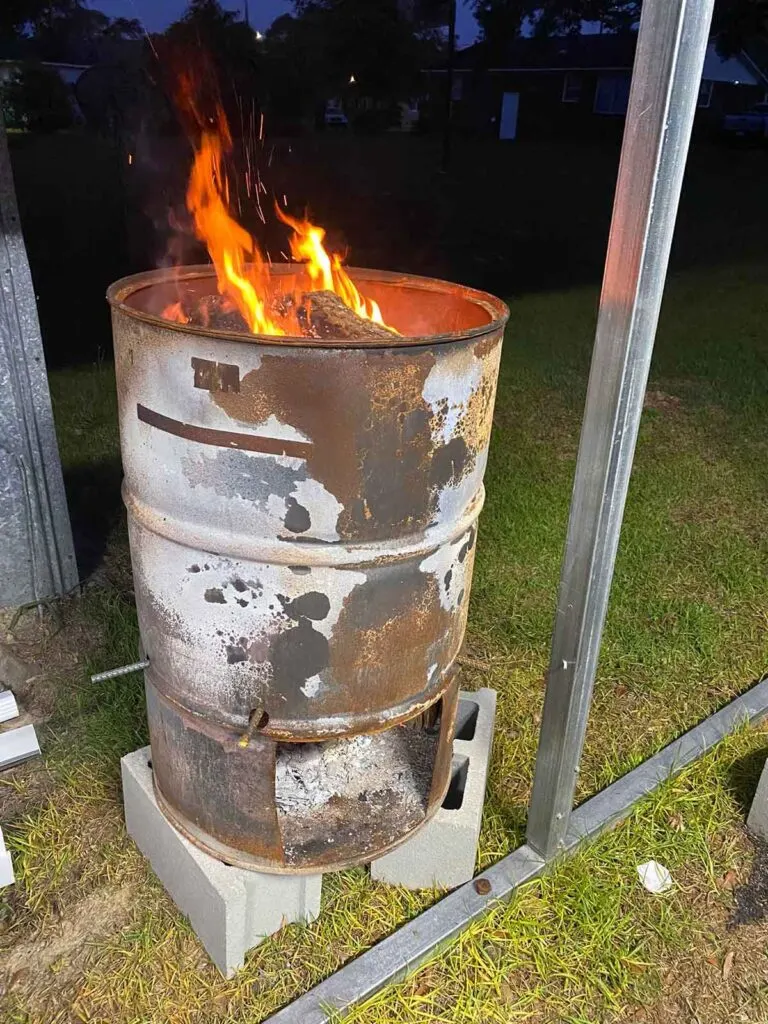
Photo courtesy of Jason Eric Francis
“Building a burn barrel to produce wood coals may seem like a luxury that can be skipped over. It’s not. Besides providing hours of visual entertainment during the long cook, it produces quality coals rapidly. It’s also more efficient than building an open fire, which gives you as much ash as it does coals, and don’t even think about simply cooking with the heat of a big fire in the pit. The hog will be burnt before it’s medium-rare inside.”
Sam Jones, author Whole Hog BBQ
Understanding the Burn Barrel
The burn barrel is one of two critical tools for the whole hog pitmaster, the other being the pit itself, often a simple cinder block pit. But what exactly is a burn barrel and how do you make one?
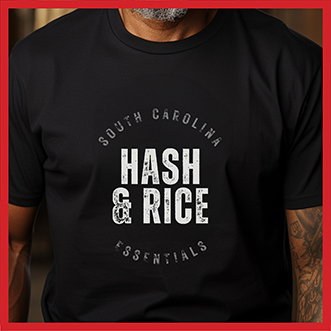
Gifts for Your Favorite Pitmaster
(even if that’s you!)
On
Etsy
Shirts, hats & more designed exclusively by Destination BBQ
Imagine a modified 55-gallon drum that you load up with hardwood logs through the open top, and inside, crisscrossed rods or stakes poke through the sides of the barrel to hold the wood in place. As the logs burn, the embers fall down, ready to be scooped out from the bottom opening.
These embers are like culinary gold, providing a consistent and reliable heat source for your barbecue. And while it’s not something you’d necessarily want to spark up just to cook a steak on the grill, if you want heat and flavor for a long cook — like a whole hog — the burn barrel is your best friend.
Design
Burn barrels often start their journey as repurposed 55-gallon drums, chosen for their ruggedness and roominess. These barrels’ lids (if still attached) are cut away to make an open top. That makes tossing in hardwood logs a breeze, ensuring a steady supply of fuel for your cook.
Inside the burn barrel, you’ll find a clever arrangement of crisscrossed rods or stakes. They form a supportive framework, keeping the wood in place as it burns. This not only helps with proper airflow but also encourages efficient combustion, resulting in those sought-after quality embers.
And don’t worry, because they are made of steel, these burn barrels are built to last. Their sturdy construction can handle the heat, ensuring they’ll be with you for many barbecue sessions to come.

Photo courtesy of Keith DuBose
When it’s time to start shoveling out your coals, you’ll do so through a convenient opening cut out at the base of the barrel. Typically, the hole is cut to be slightly wider than a shovel, but not so wide that the integrity of the drum is damaged. Through this, you can easily scoop out the embers you need for your cook.
Occasionally, burn barrels feature ventilation holes or slits to ensure sufficient airflow. These openings foster combustion, helping the wood burn down into those embers.
Of course, safety is of utmost importance. Burn barrels are designed with heat-resistant materials and sturdy construction to minimize any risks during the barbecue process.
Understanding the construction and design elements of burn barrels allows barbecue enthusiasts to make informed choices. Whether you’re selecting a ready-made burn barrel or crafting one yourself, these considerations ensure you’re equipped with the right tool to harness the power of wood-fired embers and elevate your barbecue game to new heights.
Making a Burn Barrel
Here’s a bullet list of the required tools and materials for building a burn barrel:
Tools
- Safety goggles
- Gloves
- Drill with a steel step drill bit
- Reciprocating saw
- 8-inch metal-cutting blade
- Shovel (preferably with a flat head and long handle)
- Hammer
Materials
- 55-gallon steel barrel (typically an old discarded barrel, but can be bought new)
- Concrete stakes (or rebar)
- Concrete blocks
Directions
Here are step-by-step directions for building a burn barrel modeled from expert directions provided by Jones in his book and James Beard Award-winning pitmaster Rodney Scott in his book World of BBQ.
This is not rocket science. So before we get into the directions which seem to make everything look more difficult than it is, let’s put this in simple terms:
Get a barrel like those above. Take the top off. Cut out a rectangle at the bottom, wider than your shovel and up almost to the bottom ring. Make some holes around the barrel just above the bottom ring and push some rebar (or concrete stakes) in one side and out the other, enough of them crossing over the others to hold wood from falling through. Put the barrel on some concrete blocks (optional). Start your fire.
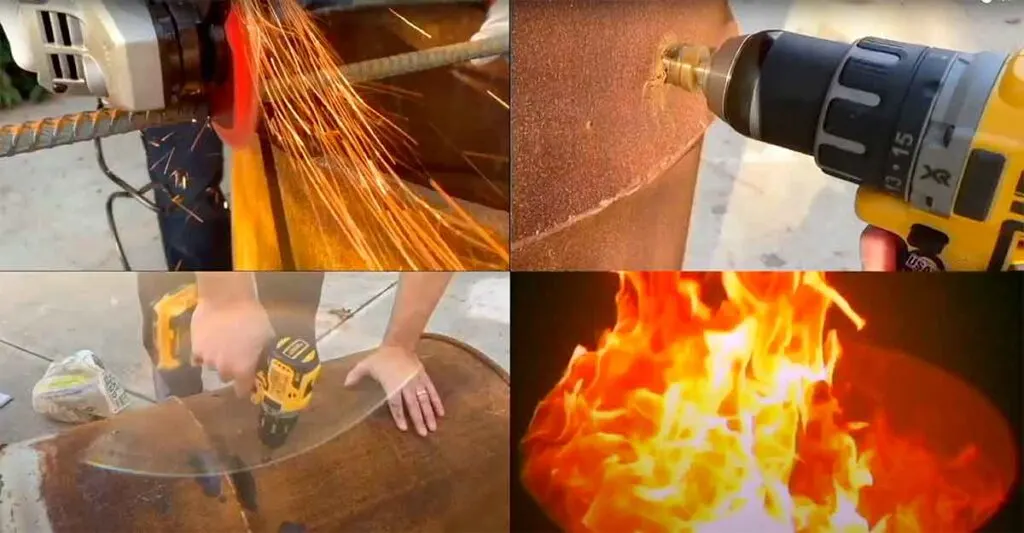
That’s pretty much it. But here it is in more detail:
- Put on your safety goggles and gloves for protection throughout the construction process.
- Start by removing the lid from the 55-gallon steel barrel, if it has one. Discard.
- If the barrel has a solid lid, use the drill with a steel step drill bit to drill a hole in the top of the barrel near the edge. (Don’t make the hole on the side of the barrel but from the top.) Ensure the hole is large enough for the cutting blade of the reciprocating saw to fit into.
- Insert the reciprocating saw blade into the hole you drilled and cut close to the edge of the barrel, sawing all the way around until the top is completely separated. Avoid cutting off the lip of the barrel, as it provides stability.
- Lay the barrel on its side and use the shovel to mark the lines for the shovel opening at the bottom of the barrel. The top of the opening should be just below the lower rib of the barrel. Use the width of the shovel to determine the width of the opening. Make it slightly wider than your shovel.
- With the lines marked, drill a hole in each corner of the shovel opening. Make sure to cut the opening just above the actual floor of the barrel, as the solid barrel floor will be slightly higher than the bottom edge.
- Use the reciprocating saw to cut between the drilled holes, creating the shovel opening.
- Turn the barrel upright and use the drill with the steel step drill bit to drill holes for the concrete stakes (or rebar). These holes should be just above the lower rib of the barrel and will hold the flaming logs above the bottom of the barrel. Drill holes for two perpendicular layers of stakes, with three holes for the bottom layer and two for the top layer.
- Ensure that the holes in one direction are slightly higher than the other to avoid the stakes hitting each other when inserted.
- Now, insert the concrete stakes (or rebar) through the holes you drilled, ensuring they are securely in place. The stakes will act as support for the wood inside the burn barrel.
- Take two or three concrete blocks and arrange them as a base for the burn barrel. This will create a stable platform.
- Finally, place the burn barrel on top of the concrete block base, ensuring it is balanced and secure.
Congratulations! You have successfully built your own burn barrel using the specified tools and materials. Now you can enjoy the process of creating wood embers for your barbecue and enhance your outdoor cooking experience. Remember to exercise caution and follow safety guidelines when using the burn barrel.
Other Options
If you don’t have the time or desire to make a burn barrel, there are alternatives.
You could simply build a fire on the ground or on concrete blocks and scoop embers from the base.
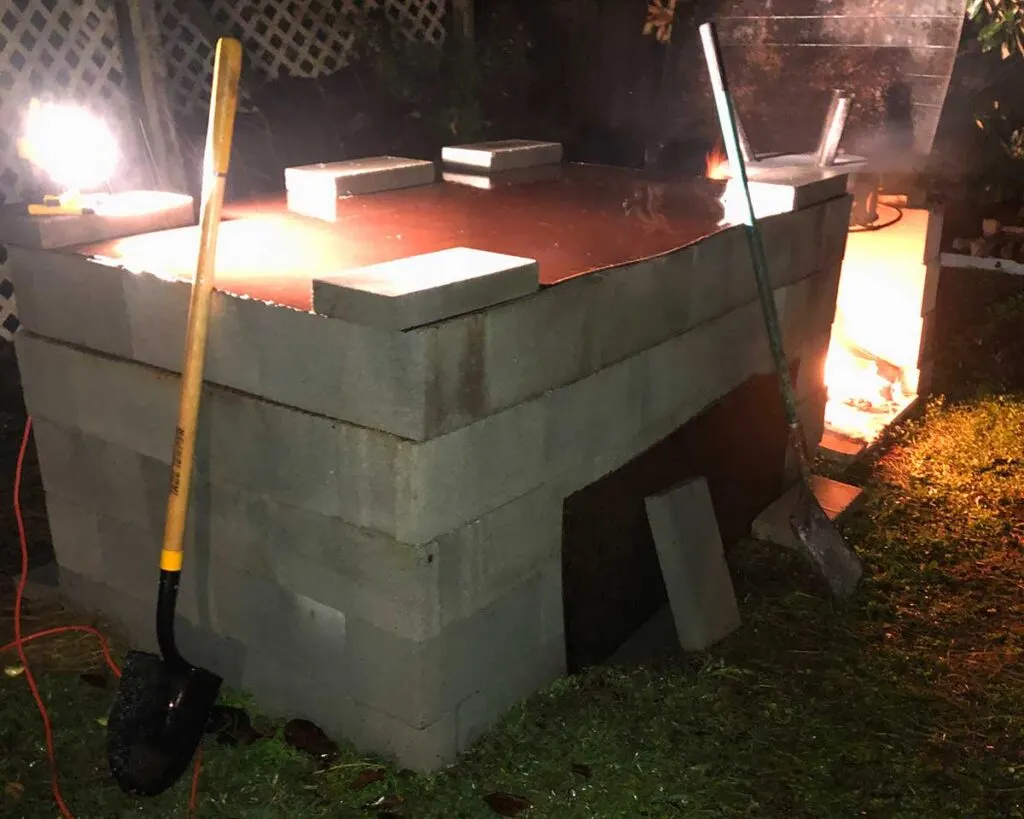
Or you could use a fire pit.
“One time I was invited to cook out of town and they didn’t have a burn barrel,” Scott wrote in his book. “I used a large cast-iron fire pit, the kind people sometimes use like a campfire to gather around on chilly nights when they want to sit outside.
“You can buy fire pits for less than $100, although I’ve seen them for several hundred dollars as well. If you go the fire pit route, be sure you buy one that has a wide enough circumference to allow you to easily dip your shovel beneath the burning wood to reach the coals.
“Building a burn barrel will definitely make your life easier in the long run if you use it often.”
Word of Warning
As with any fire source, caution is advised when using a burn barrel.
- Choose a safe, well-ventilated area away from flammable materials.
- Have fire extinguishing equipment nearby, just in case.
- Always keep the fire under supervision.
- Be aware of any local regulations or restrictions.”Learn about burn barrels for BBQ and how to build your own. Explore design details, step-by-step instructions, safety tips, and alternatives in this comprehensive guide.”
- Wear appropriate clothing.
As Jones notes, “Dress properly for whole hog cooks. There are sparks everywhere. If they land on your fleece or puffy jacket, those marks won’t wash out. Wear flannel or a wool or canvas jacket that doesn’t easily burn or melt.
“The sparks that don’t land on your clothes and burn holes in them become ash dust, and it’s everywhere. Wear light gray clothes and a hat to blend in, but you should still expect a few dandruff jokes.”
« See Full Glossary Index